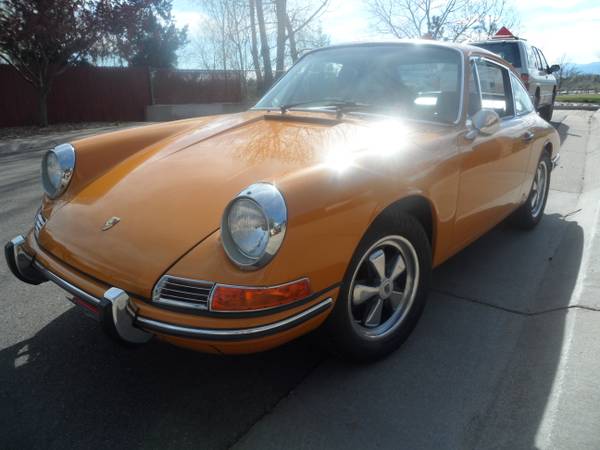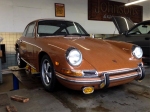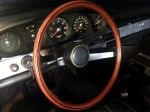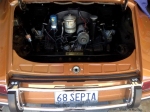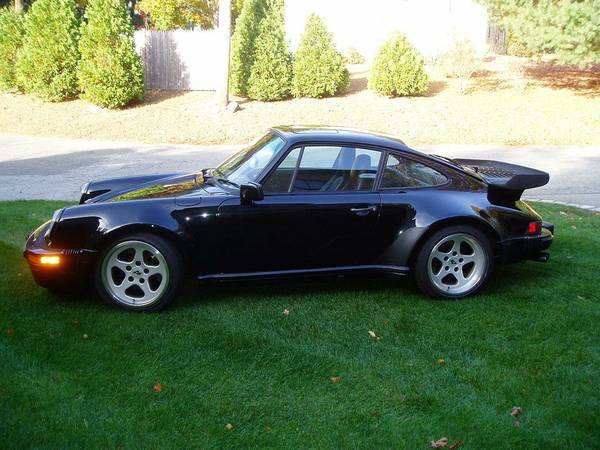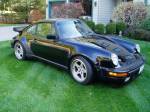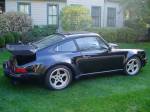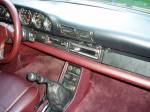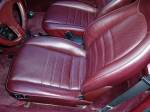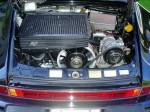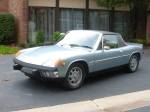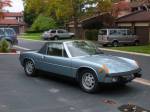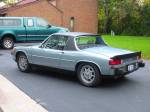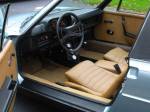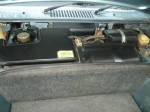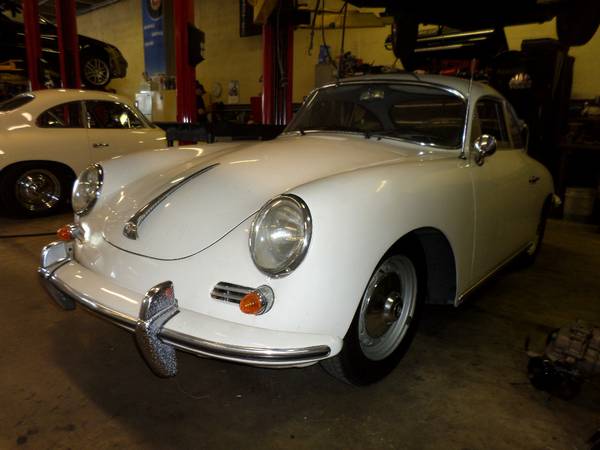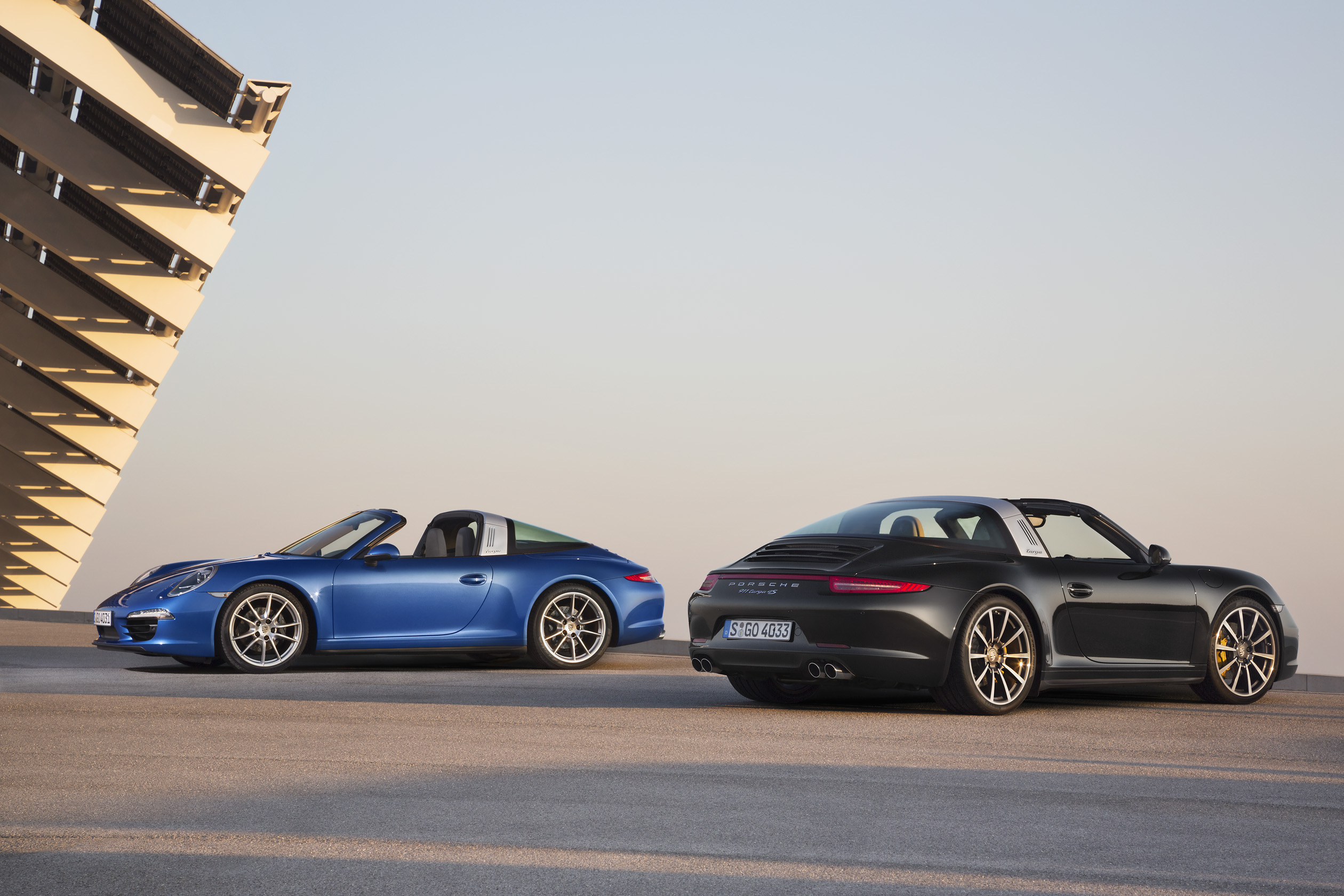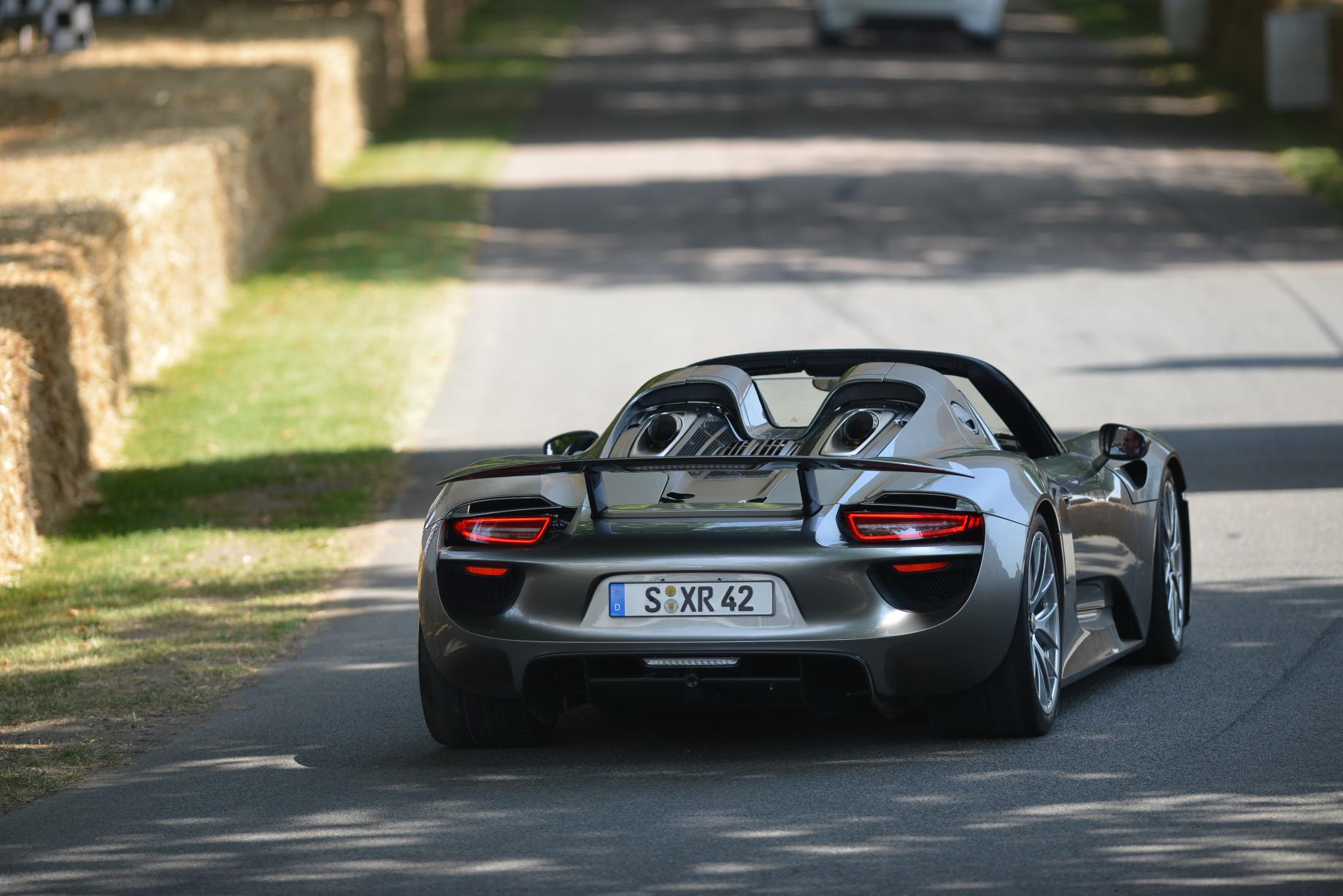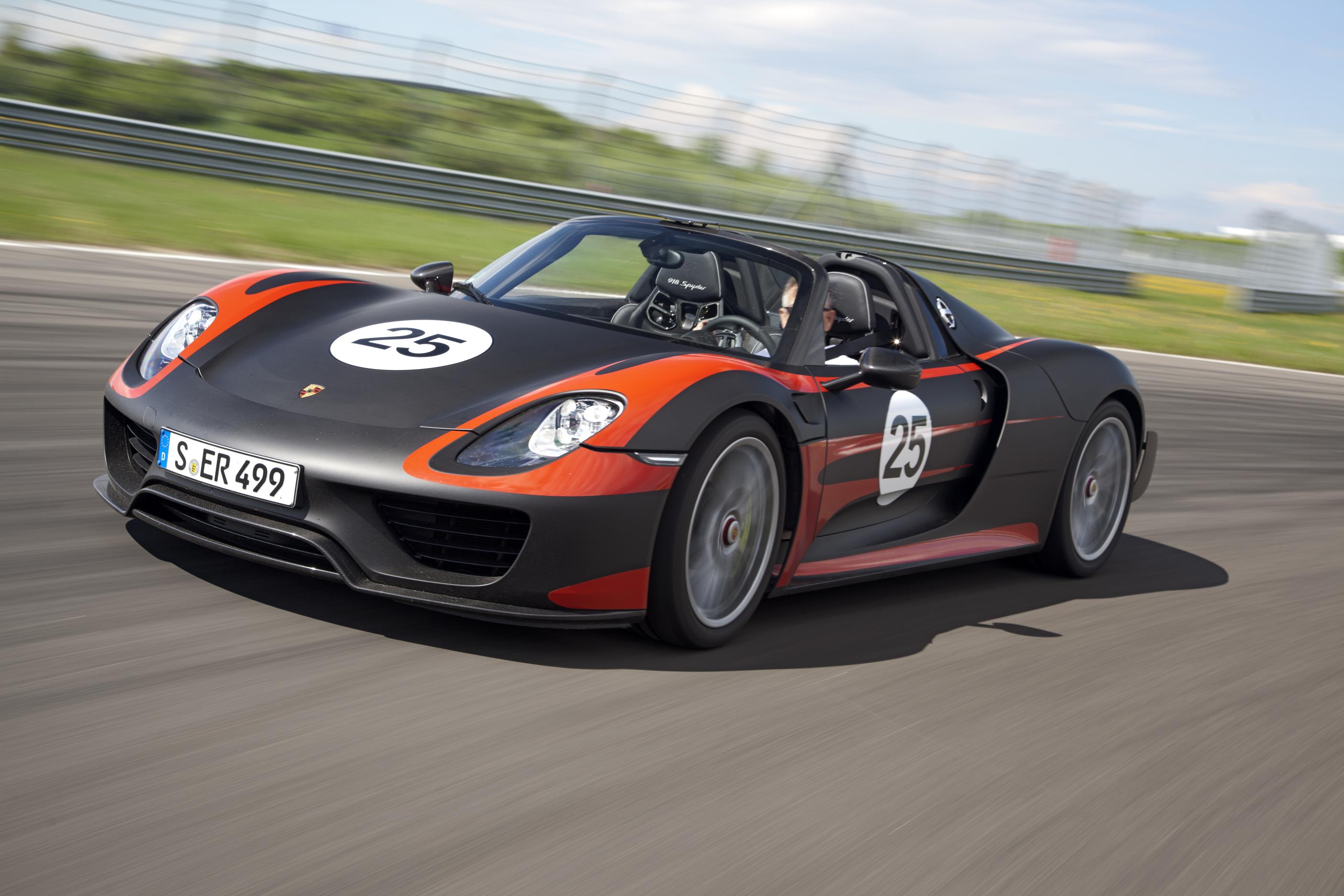While Porsche cars today are built entirely in its original Stuttgart factory as well as others in Finland and Slovakia, prior to the early 60s, its bodies were made by coachbuilders like Reutters, D’Iterien, Drauz, and Karmann before being assembled at the Zuffenhausen plant. After Porsche’s acquisition of Reutters, they continued to use Karmann for some 911 and 912 production (and later 914 and 968). There is some ürban legend that the Karmann bodies were lighter than the Porsche factory bodies, but this is more likely because most Karmann-built bodies were used in base 911, 911T and 912 production. These cars were more sparsely equipped—but only by perhaps a few kilos—than the 911S and 911L that were exclusive to the Porsche factory. In reality, a 911 built by Karmann is identical to a works one. There is also varying opinions that a 911 that’s pure Porsche should be worth more, while there’s a counter-argument that in an effort to win more of Porsche’s business, Karmann went beyond spec to build better cars. Fifty years later, it’s all minutia at best. An early 911 is highly collectible and very valuable. Period. In the last six months alone, actual sales prices have escalated an astonishing 15% and they continue to rise with even steeper growth. Simply put, there is no better investment in the automotive world—and very little outside of it—than an early 911. This example is a 1968 911 Karmann Coupe with an older restoration that has held up extremely well, with matching numbers against a Certificate of Authenticity. It is said to be absolutely rust-free with perfect paint and flawless interior. With just over 50,000 original miles on the clock and recent service that includes valve and carburetor adjustment, this is a car that doesn’t ignore these cars’ intent to be driven while looking exceptionally good. Bahama Yellow is perfect for the vintage and is a perennial favorite among Porsche collectors. It’s as good as it gets for under six figures. Find it here on Craigslist in Arvada CO for $85,000.
Tag: Porsche (Page 2 of 3)
Anyone who has followed the market on the original short-wheelbase Porsche A Modelles can speak to their stratospheric appreciation, particularly since the recent Spring auctions. An SWB 911 is getting out of reach for most hobbyist collectors and becoming blue-chip. But there is a glimmer of hope. As it did when it was introduced in 1965, the 912 offers much of the same joys of owning a classic Porsche at prices that are still attainable. With their iconic looks, nimble handling and go-the-distance fuel economy, the Porsche 912 is a Cinderella story in the making. Finding a 912 that hasn’t been treated like the unworthy stepsister can be a grim task. Likewise, to bring one back to its deserved glory can be more trouble than its worth—literally. The 912 presented here has been exceptionally well preserved, with a numbers matching drivetrain, original interior and one repaint on a rust-free, accident-free body. Sepia Brown may not get a lot of love, but it is the original color and not at all out of character for a late 60s German sports car. It has some desirable options like original headrest and fog lamps as well as the expensive wood steering wheel (no mention whether that’s original but the forthcoming CoA will clarify). Pictured with the extra cost Fuchs, but correct stamped chrome steelies come with the car (which look more appropriate on a 912 anyway). It is said to be in an excellent mechanical state with recent tune up, carb cleaning and new gaskets, as well as new service distributor, belts, points and wires. It also has a reconditioned OEM gas tank, had brakes serviced and replaced all fluids, torsion bar bushings, battery, and OEM valve springs. Having been lowered two inches not only improves the already excellent handling of a 912, but makes it look more purposeful. It is being offered for sale by a noted early Porsche collector. Find it here on The Samba in Los Angeles CA for a reasonable $40,000.
There are few cars that conjure teenage bedroom poster images more than a Porsche 930. With its outrageous fender flares that house distended tires and a leviathan tail on the boot, it had the aggressive looks to go with its neck-snapping, race-bred performance. It was disco-80s excess. Having returned to the US after a six-year hiatus, the 1986 Porsche 930 was a welcome sight on interstates, twisty roads and track days across the country. And it remains so today. The only problem, if you can call it that, with the 930—until it received a one-year-only G50 transmission in 1989—was that all that power was managed through a 4-speed with sky-high gear ratios. It would’t be inconceivable to drive through town at normal speeds without getting out of first gear. As such, they’re not especially drivable on a routine basis. Enter Ruf Automobile, a German tuner that’s been making Porsches not only more powerful, but more drivable since 1975. In 1983, Ruf tuned a 930 Turbo for Group B (a largely unrestricted racing class with limited homologation) and the first Ruf BTR rolled out of their facility in Pfaffenhausen. By this time, Ruf’s integrity toward what made a Porsche a Porsche had earned them tuning centers within Porsche’s authorized dealer network, whereby customers could have their cars tuned to Ruf spec. The car presented today began life as a nothing-to-sneeze-at 1986 930 Turbo and was converted to Ruf BTR3 Spec in 1987 through one of those authorized dealers. This included the BTR’s 3.4 litre 410-hp motor along with a Ruf 5-speed gearbox that made better use of its powerband. Also included are Ruf brakes, steering wheel, front air dam, and badges. Not to mention the iconic Ruf wheels. With 50,000 miles on the clock it is fresh without being overly nursed and its black on burgundy combo is a perfect expression of refined yet sinister. Find it here on Craigslist in Lexington MA for a not unreasonable $65,000.
The Porsche 914 wasn’t always a collector’s dream. Many saw it as more VW than Porsche and indeed gave the Karmann Ghia more respect. Recently however, as other air-cooled cars are escalating to prices that are no longer appealing to the hobbyist collector, a growing number have cast aside earlier judgment and have actually driven them to find they deserve the Porsche on their own merit. Particularly in the later (1973-76) 2.0 litre form, they are enjoyable in a different sort of way than say a 911 of the same era, but immensely enjoyable nonetheless.
The car presented here appears to check all the boxes of what a good Porsche 914 ought to be. It’s a 2.0 Litre that has enough integrity to be called original, but with enough modifications to harness what these cars are truly about. It is said to be rust-free, which is the first concern in looking at a 914. Its unique Marathon Blue finish appears to be in good shape and, save for a few easily repairable blems, looks to be very straight. It has the preferable chrome bumpers (last seen in 1974) and sits nicely on optional Mahle wheels. Interior also appears to be in good shape with only a couple easy nicks and cracks to sort out. The motor is said to have been professionally rebuilt and bored to 2056 cc (stock is 1971 cc) with the factory fuel injection replaced with dual Webers (commonly done) although the original fuel injection is included in the sale as are a set of larger Webers. On paper, it has all the makings of a car that is a kick in the pants to drive and a smart investment. Find it here on Craigslist in Detroit MI for $8,500.
1963 Porsche 356C Coupe odometer: 93211 VIN: 212617
Very nice running and driving 356C Coupe. Ivory w/black interior, original radio. Older repaint with very little surface rust. Drives great and the brakes work like they should.
These cars are going up in price daily.
Chassis#212617
Engine#701033
| VIN | 12870065 |
| Exterior | [6804] Light Ivory |
| Interior | [B] Black Leatherette |
| Motor | 1.6 L H4 rated at 90 bhp |
| Gearbox | [902/02] 5-Speed Manual |
| Exterior Condition | Outstanding (1) |
| Interior Condition | Outstanding (1) |
| Drivetrain | Outstanding (1) |
| Braking | Excellent (2) |
| Suspension/Ride | Excellent (2) |
| Tires/wheels | Good (3+) |
APPRECIATING CLASSIC Anyone who has followed the market on the original, Butzi-designed, short-wheelbase Porsche A Modelles can speak to their stratospheric appreciation, particularly since the recent Arizona auctions. Sadly, the dream of owning a 1965-1968 Porsche 911 is getting out of reach for most hobbyist collectors. But there is a glimmer of hope. As it did when it was introduced in 1965, the 912 offers much of the same joys of owning a classic Porsche at prices that are still reasonable. With their iconic looks, nimble handling and go-the-distance fuel economy, the Porsche 912 is a Cinderella story in the making. However, finding a 912 that hasn’t been treated like the unworthy stepsister can be a grim task. Likewise, to bring one back to its deserved glory can be more trouble than its worth—literally. The 912 Targa presented here has been painstakingly restored to a high standard from the ground up and it sits today much like it did on the showroom floor in 1968.
HISTORY AND CONDITION
This 912 owes much of its restoration quality to its history. With only two prior owners from dry climates (California and New Mexico), the rust that plagues early Porsches was not a factor. There was no rot on the body whatsoever and with new floors and longitudinals, the carriage is factory fresh. Its bare-metal paint was done to a very high standard as an exact factory match to its original and desirable Light Ivory color. Gaps are near perfect—exceptional for an almost 50-year-old open-roof car. All seals, felt and rubber trim were replaced for a solid, like-new feel. The interior is completely new including cushions, upholstery, dash, carpets and trim. It truly is a throwback to how it would’ve felt behind the wheel in 1968. The correct motor and transmission are a nuts-and-bolts rebuild and with less than 300 miles since, it feels fresh and surprisingly lively. That’s due in part to its Weber carburetors, though the factory Solex are also included in the sale. The Fuchs wheels are in excellent condition with no curb rash and very good finish (Certificate of Authenticity shows the car delivered with Steelies, one of the only things NOT original to the car). All hinges, struts, latches, etc. work properly. Also included are hard-to-find items like complete tool roll and original (not reprint) owner’s manual.
At the North American International Auto Show in Detroit today (13 January), Porsche is presenting the latest addition to the iconic 911 sports coupé family: the 911 Targa. While enthusiasts will recognise cues from the classic Targa concept, pioneered by Porsche in the late 1960s, this latest model is the first to combine state-of-the-art open roof technology with the distinctive coupé appearance.
Just like the legendary original 911 Targa model, the new model features a characteristic wide bar in place of the B-pillars aft of the doors, a movable roof section above the driver and passenger, and a wrap-around rear window — with no C-pillar. But, unlike the classic models, the roof segment of the new Targa can be opened and closed at the push of a button. When the button is pressed, the fully automatic system stows the roof top behind the rear seats, providing a real spectacle.
The rear-biased Porsche Traction Management (PTM) all-wheel drive fitted as standard is a further typical dynamic Porsche feature, and guarantees that the latest 911 Targa also offers optimum driving dynamics on all road surfaces and in all weather conditions.
With these features, the new 911 Targa presents itself as a high-quality, innovative reinterpretation of the classic first edition from 1965. The model shares a great deal in common with the 911 Carrera 4 Cabriolet models; up to the window line, the technology and body of the vehicles is virtually identical. The combination of the wide rear body that is typical of all-wheel drive 911 models, the Targa roof bar and the dome-shaped rear window create a low-slung profile that gives the latest 911 an extremely sporting appearance.
New and spectacular – the fully automatic Targa roof
The Targa roof system has always been a distinctive hallmark of this 911 model. The new 911 Targa continues this tradition with a particularly innovative roof concept. The roof is made up of two movable parts: a soft top and a glass rear window. The rear window, which is attached to the convertible top
compartment lid, is opened and tilted at the push of a button. At the same time, two flaps open in the Targa bar, releasing the soft top’s kinematics. The convertible top is released, folded into a Z-shape as the roof opens, and stowed away behind the rear seats. A stowage area running across the car behind the rear seats accommodates the convertible top. Once the top has been stowed, the flaps in the bar close and the rear window moves back in to position once again. The roof takes around 19 seconds to open or close using the buttons in the centre console – and can be operated only while the vehicle is stationary. A wind deflector integrated in the cowl panel frame can be erected manually when the top is down. This deflector reduces drafts and buffeting in the interior by a considerable margin, should this be the driver’s preference.
Intelligent lightweight construction using steel, aluminium and magnesium
The materials used in the roof system are just as innovative as the concept itself. The premium quality fabric hood is stretched particularly taut by the magnesium roof shell and panel bow. An additional sound absorber beneath the convertible-top covering has a thermal-insulating effect and reduces road noise when the roof is closed. The rear edge of the soft top connects up to the fixed Targa bar, which features steel roll-over protection on the inside and painted cast aluminium elements on the outside. The three gills and ‘targa’ lettering on the sides of the bar are a subtle leitmotif inspired by the original 1965 Targa model.
The rear window, which is made from extremely lightweight laminated safety glass, consists of two layers of thin, partially pre-tensioned glass separated by a film interlayer. The very fine heating elements on the heated rear window cover almost the entire surface of the glass, ensuring exceptional all-round visibility even in unfavourable weather conditions.
Inside the cabin, the front roof element is lined with black fabric, which, together with the black Alcantara interior trim of the Targa roof bar, gives the interior a harmonious appearance. The convertible-top compartment is situated behind the rear seats. This compartment, together with the transverse strut, serves to harmoniously integrate the stowed convertible top into the cabin. Even with the roof closed, the large, curved rear window allows plenty of light into the interior, providing a notable feeling of space.
Two model variants, exclusively with all-wheel drive
As with the prior model, the new Targa comes in two versions available exclusively with all-wheel drive. A seven-speed manual transmission is fitted as standard. The 911 Targa 4 is powered by a 3.4-litre, 350 hp (257 kW) flat-six engine. Equipped with the optional Porsche Doppelkupplung (PDK) double-clutch transmission and Sport Chrono Package, this model can accelerate from 0 to 62 mph in just 4.8 seconds and on to a top speed of 175 mph. Fuel consumption on the NEDC is between 29.7 mpg and 32.5 mpg Combined, depending on transmission, which corresponds to CO2 emissions between 223 and 204 g/km.
The top model is the 911 Targa 4S, which delivers 400 hp (294 kW) from a displacement of 3.8 litres. This model reaches a top speed of 184 mph and, with the PDK and Sport Chrono package options specified, is able to accelerate from 0 to 62 mph in 4.4 seconds. Fuel consumption on the NEDC is between 28.2 mpg and 30.7 mpg, depending on transmission, which corresponds to CO2 between 237 and 214 g/km. These figures place the model on a par with the high standard set by the 911 Carrera 4 Cabriolet models in terms of engine and road performance, as well as efficiency. Furthermore, both sports cars are certified for compliance with the Euro 6 emissions standard.
The new 911 Targa models are available to order from Porsche Centres in the UK and Ireland from today, with first cars arriving in showrooms in May. The 911 Targa 4 is priced from £86,281, the 911 Targa 4S priced from £96,316. In Ireland, the Targa 4 is priced from €153,162, and the Targa 4S from €175,213.
Standard equipment on each model includes leather interior, sports seats, automatic climate control, Bi-Xenon headlights, 7-inch colour touch-screen Porsche Communication Management with satellite navigation, digital radio, a universal audio interface offering MP3 connectivity, Porsche Stability Management (PSM), Porsche Traction Management (PTM) all-wheel drive and a three-year warranty.
The 911 Targa 4S adds 20-inch alloy wheels, Porsche Active Suspension Management (PASM) and Porsche Torque Vectoring (PTV) with rear limited slip differential, in addition to the power advantage of the larger 3.8-litre engine.
Fitted to every 911 is a Porsche Vehicle Tracking System (VTS), a sophisticated vehicle security package approved to Thatcham Category 5 standard, and customers will also be able to explore the potential of their new car by participating in a complimentary course at the Porsche Experience Centre, Silverstone.
The history of the Porsche 911 Targa
Porsche unveiled the 911 Targa, the world’s first ever ‘safety Cabriolet’, in September 1965 at the International Motor Show (IAA) in Frankfurt, Germany. With its fixed roll-over bar, removable folding roof and hinged rear window, this new variant was developed primarily in response to increased safety legislation in America. The name ‘Targa’ comes from the famous Targa Florio race and since the mid-sixties has been synonymous with the open driving concept, which was new at the time.
Production of the vehicle began towards the end of 1966 with the market launch of the 911 Targa taking place in 1967. The Targa cost 1,400 Deutschmarks more than the Coupé. This roof concept was enhanced from one 911 generation to the next over a period of 27 years. During this time, this ‘semi-open’ variant acquired the status of a stand-alone vehicle concept in the Porsche range, becoming the model of choice for one in ten 911 buyers.
For the 1996 model year, Porsche presented a fully revised version of the 911 Targa (‘Type 993’). The entire roof was made of glass, with a sliding glass cover above the driver and front seat passenger that could be lowered and retracted beneath the hinged rear glass window.
Precisely 20 years after the last 911 Targa with the classic roll-over bar style (based on the ‘Type 964’) was discontinued, the latest ‘Type 991’ generation of the 911 Targa once again takes this unique design concept into the future.
The Porsche 918 Spyder super sports car made its public dynamic debut at the Goodwood Festival of Speed, in a demonstration run up the famous Hill that provided a fascinating insight to the performance potential of its innovative hybrid drivetrain.
The 918 Spyder embodies the essence of the Porsche idea: it combines pedigree motor racing technology with excellent everyday versatility, and maximum performance with minimum consumption. The task faced by the development team was to create the super sports car for the next decade with a highly efficient and powerful hybrid drive.
Developing the car from scratch with a clean sheet of paper allowed Porsche engineers to come up with a no-compromise concept. The entire car was designed around the hybrid drive. The 918 Spyder therefore demonstrates the potential of the hybrid drive to a degree never before seen: the parallel improvement of both efficiency and performance without one being at the cost of the other. This is the idea that has made the Porsche 911 the most successful sports car in the world for 50 years. In short, the 918 Spyder will act as the gene pool for the Porsche sports cars of the future.
The 918 Spyder reveals its close links to motorsport in a variety of ways. It has been designed, developed and produced by Porsche engineers who build race cars, in co-operation with series production specialists. A great deal of insight gained from the development of Porsche race cars for the Le Mans 24 hours in 2014 is thus integrated into the 918 Spyder – and vice versa. The structural concept of the 918 Spyder with a rolling chassis as its basis – a basic vehicle that can be driven even without a body – is race car tradition at Porsche. The concept of the V8 engine originates from the LMP2 RS Spyder race car. The load-bearing structures, the monocoque and subframe, are made of carbon fibre reinforced polymer (CFRP). Porsche has many years of experience with this high strength, lightweight construction material and has again achieved top results with the development of the series production 918 Spyder. Many parts of the super sports car come from manufacturers who have a proven record as suppliers for motorsport vehicles.
Hybrid drive brings advantages in terms of driving dynamics
A key message of the 918 Spyder is that the hybrid drive from Porsche is a plus for no-compromise driving dynamics. Drivers can experience this thanks to the unique all-wheel drive concept with a combination of combustion engine and electric motor on the rear axle and the second electric motor on the front axle.
It is based on knowledge gained by Porsche racing the successful 911 GT3 R Hybrid. Due to the additional, individually controllable front drive, new driving strategies for extremely high, safe cornering speeds can be implemented. Furthermore, the advanced ‘boost’ strategy manages the energy of the electric drive so intelligently that for every sprint with maximum acceleration, the full power of the 918 Spyder can be tapped into simply by fully pressing the accelerator down. In short, the 918 Spyder allows all drivers to experience the potential of advanced longitudinal and transverse dynamics.
The Porsche 918 Spyder also has the potential to break many records. The current lap time for the Nürburgring-Nordschleife is 7:14 minutes. This time was achieved in the presence of international journalists during test drives in September 2012 – more than a year before start of production. The 918 Spyder prototype was therefore approximately 20 seconds quicker than the Porsche Carrera GT. More test drives on the Nürburgring will follow.
An even more important factor is that the 918 Spyder surpasses previous models and competitors by far in its efficiency as well. As a plug-in hybrid vehicle, it systematically combines the dynamic performance of a racing machine with over 880 hp and low NEDC fuel consumption, which at about three litres fuel per 100 km is better than that of most small cars today. To sum it up, maximum driving fun with minimal fuel consumption.
Carbon monocoque guarantees lightweight design with a low centre of gravity
The 918 Spyder utilises the best state-of-the-art technologies, taken straight from motor racing, to achieve its top performance. The entire load-bearing structure is made of carbon fibre reinforced polymer for extreme torsional rigidity. Additional crash elements at the front and rear absorb and reduce the energy in a collision. The unladen weight of approximately 1,640 kg (with ‘Weissach’ package), an excellent low weight for a hybrid vehicle of this performance class, is largely attributable to this concept. The drivetrain components, and all components weighing over 50 kg, are located as low and as centrally as possible within the vehicle. This results in a slightly rear-biased axle load distribution of 57 per cent on the rear and 43 per cent on the front, combined with an extremely low centre of gravity at approximately the height of the wheel hubs: ideal for driving dynamics. The central and low position of the traction battery directly behind the driver not only supports efforts to concentrate masses and lower the centre of gravity, it also provides the best temperature conditions for optimum battery power capacity.
Chassis with race car genes and rear-axle steering
The multi-link chassis of the Porsche 918 Spyder is inspired by motorsport design, complemented by additional systems such as the Porsche Active Suspension Management (PASM) adaptive shock absorber system and rear-axle steering. This incorporates an electro-mechanical adjustment system at each rear wheel. The adjustment is speed-sensitive and executes steering angles of up to three degrees in each direction. The rear axle can therefore be steered in the same direction as the front wheels or in opposition to them. At low speeds, the system steers the rear wheels in a direction opposite to that of the front wheels. This makes cornering even more direct, faster and more precise, and it reduces the turning circle. At higher speeds, the system steers the rear wheels in the same direction as the front wheels. This significantly improves the stability of the rear end when changing lanes quickly. The result is very secure and stable handling.
Porsche Active Aerodynamic (PAA) for different driving modes
Porsche Active Aerodynamic (PAA), a system of adjustable aerodynamic elements, ensures unique and variable aerodynamics. Its layout is automatically varied over three modes ranging from optimal efficiency to maximum downforce and is tuned to the operating modes of the hybrid drive system.
In ‘Race’ mode, the retractable rear wing is set to a steep angle to generate high downforce at the rear axle. The spoiler positioned between the two wing supports near the trailing edge of the airflow also extends. In addition, two adjustable air flaps are opened in the underfloor in front of the front axle, and they direct a portion of the air into the diffuser channels of the underbody structure. This also produces a ‘ground effect’ at the front axle.
In ‘Sport’ mode, the aerodynamic control system reduces the attack angle of the rear wing, which enables a higher top speed. The spoiler remains extended. The aerodynamic flaps in the underfloor area close, which also reduces aerodynamic drag and increases attainable vehicle speeds.
In ‘E-Power’ mode, the control is configured entirely for low aerodynamic drag; the rear wing and spoiler are retracted and the underfloor flaps are closed. Adjustable air inlets under the main headlights complete the adaptive aerodynamic system.
When the vehicle is stationary or in ‘Race’ and ‘Sport’ mode, they are opened for maximum cooling air intake. In ‘E-Power’ and ‘Hybrid’ modes, they close immediately after the car is driven off in order to keep aerodynamic drag to a minimum. They are not opened until the car reaches speeds of approximately 130 km/h or when cooling requirements are higher.
From comfortable to race-ready: five modes for three motors
The core of the 918 Spyder concept is its distribution of propulsive power among the three power units, and their co-operation is controlled by an intelligent management system. To best exploit these different approaches, Porsche engineers defined five operating modes that can be activated via a ‘map switch’ on the steering wheel, just like a race car. On the basis of this pre-selection, the 918 Spyder applies the most suitable operating and boost strategy without driver intervention, thus allowing the driver to concentrate fully on the road.
Quiet and elegant: ‘E-Power’
When the vehicle is started up, ‘E-Power’ is the default operating mode as long as the battery is sufficiently charged. In ideal conditions, the 918 Spyder can cover over 18 miles (30 km) on purely electric power. Even in pure electric mode, the 918 Spyder accelerates from 0 – 62 mph in less than seven seconds and can reach speeds of up to 93 mph. In this mode, the combustion engine is only used when needed. If the battery’s charge state drops below a set minimum value, the vehicle automatically switches to hybrid mode.
Efficient and comfortable: ‘Hybrid’
In ‘Hybrid’ mode, the electric motors and combustion engine work alternately with a focus on maximum efficiency and minimum fuel consumption. The use of individual drive components is modified as a function of the current driving situation and the desired performance. The Hybrid mode is typically used for a fuel economy-oriented driving style.
Sporty and dynamic: ‘Sport Hybrid’
In more dynamic situations, the 918 Spyder selects the “Sport Hybrid” mode for its power sources. The combustion engine now operates continuously and provides the main propulsive force. In addition, the electric motors provide support in the form of electric boosting or when the operating point of the combustion engine can be optimised for greater efficiency. The focus of this mode is on performance and a sporty driving style at top speed.
For fast laps: ‘Race Hybrid’
‘Race Hybrid’ is the mode for maximum performance and an especially sporty driving style. The combustion engine is chiefly used under high load, and charges the battery when the driver is not utilising its maximum output. Again, the electric motors provide additional support in the form of boosting. Furthermore, the gear-shifting programme of the PDK is set up for even sportier driving. The electric motors are used up to the maximum power output limit to deliver the best possible performance for the race track. In this mode, the battery charge state is not kept constant, but instead fluctuates over the entire charge range. In contrast to ‘Sport Hybrid’ mode, the electric motors run at their maximum power output limit for a short time for better boosting. This increased output is balanced by the combustion engine charging the battery more intensively. Electric power is thus available even with several very fast laps.
For pole position: ‘Hot Lap’
The ‘Hot Lap’ button in the middle of the map switch releases the final reserves of the 918 Spyder and can only be activated in ‘Race Hybrid’ mode. Similar to a qualification mode, this pushes the traction battery to its maximum power output limits for a few fast laps. This mode uses all of the available energy in the battery.
Main propulsion: the race car’s eight cylinder engine
The main source of propulsion is the 4.6-litre, eight cylinder engine that produces 612 hp of power. The engine is derived directly from the power unit of the successful RS Spyder, which explains why it can deliver engine speeds of up to 9,150 rpm. Like the race engine of the RS Spyder, the 918 Spyder power unit features dry-sump lubrication with a separate oil tank and oil extraction. To save weight, components such as the oil tank, the air filter box integrated into the subframe and the air induction are made of carbon fibre reinforced polymer. Further extensive lightweight design measures have resulted in such features as titanium connecting rods, thin-wall low-pressure casting on the crank case and the cylinder heads, a high-strength lightweight steel crankshaft with 180 degrees crankpin offset and the extremely thin-walled alloy steel/nickel exhaust system.
Striking features of the V8 are that it no longer supports any auxiliary systems, there are no external belt drives and the engine is therefore particularly compact. Weight and performance optimisations achieve a power output per litre of approx. 132 hp/l – the highest power output per litre of a Porsche naturally aspirated engine – which is significantly higher than that of the Carrera GT (106 hp/l) and outstanding for a naturally aspirated engine.
Unique race car design heritage: top pipes
It isn’t just this engine’s performance, but also the sound it makes that stokes the emotional appeal of the 918 Spyder. This is attributable first and foremost to the so-called exhaust ‘top pipes’: the tailpipes terminate in the upper part of the rear end immediately above the engine. No other production vehicle uses this solution.
The greatest benefit of the top pipes is optimal heat removal, because the hot exhaust gases are released via the shortest possible route, and exhaust gas back pressure remains low. This design requires a new thermodynamic air channelling concept. With the HSI engine, the hot side is located inside the cylinder V, the intake channels are on the outside. There is another benefit as well: the engine compartment remains cooler. This is especially beneficial to the lithium-ion traction battery, as it provides optimum performance at temperatures between 20 and 40 degrees Celsius. Consequently, less energy needs to be used for active cooling of the battery.
In parallel in the drivetrain: hybrid module
The V8 engine is coupled to the hybrid module, since the 918 Spyder is designed as a parallel hybrid: exactly like the current hybrid production models from Porsche. Essentially, the hybrid module comprises a 115 kW electric motor and a decoupler that serves as the connection with the combustion engine. Because of its parallel hybrid configuration, the 918 Spyder can be powered at the rear axle either individually by the combustion engine or electric motor, or via both drives combined. As is typical for a Porsche super sports car, the power pack in the 918 Spyder has been placed in front of the rear axle, and does not have any direct mechanical connection to the front axle.
Upside-down for a low centre of gravity: Porsche Doppelkupplung (PDK)
A seven-speed Porsche Doppelkupplung (PDK) transmission handles power delivery to the rear axle. The high-performance transmission is the sportiest version of the successful PDK gearbox. It has undergone a complete redesign for the 918 Spyder and has been further optimised for high performance. To ensure a low mounting position for a low centre of gravity of the entire vehicle, the gearbox was turned upside down by rotating it 180 degrees about its longitudinal axis, in contrast to other Porsche road cars. If no power is required on the rear axle, the two motors can be de-coupled by opening the decoupler and PDK clutches. This is the action behind the Porsche hybrid drive’s typical ‘coasting’ feature, with the combustion engine switched off.
Independent all-wheel drive: front axle with electric motor
On the front axle, there is another independent electric motor with an output of approximately 95 kW. The front electric drive unit drives the wheels at a fixed ratio. A decoupler de-couples the electric motor at high speeds to prevent the motor from over-revving. Drive torque is independently controlled for each axle. This makes for very responsive all-wheel drive functionality that offers great potential in terms of traction and driving dynamics.
Lithium-ion battery with plug-in charging system
The electric energy for the electric motors is stored by a liquid-cooled lithium-ion battery comprising 312 individual cells with an energy content of about seven kilowatt hours. The battery of the 918 Spyder has a performance-oriented design in terms of both power charging and output, so that it can fulfil the performance requirements of the electric motor. The power capacity and the operating life of the lithium-ion traction battery depend on several factors, including thermal conditions. That is why the battery of the 918 Spyder is liquid-cooled by a dedicated cooling circuit. The global warranty period for the traction battery is seven years.
To supply it with energy, Porsche developed a new system with a plug-in vehicle charge port and improved recuperation potential. This vehicle charge port in the B-column on the front passenger side lets users connect the storage battery to a mains supply at home and charge it. The charge port is standardised for the country of purchase. The on-board charger is located close to the traction battery. It converts the alternating current of the mains supply into direct current with a maximum charge output of 3.6 kW.
Using the supplied Porsche Universal Charger (AC), the traction battery can be charged within four hours from a ten ampere rated, fused power socket on the German 230 Volt mains supply, for example. Furthermore, the Porsche Universal Charger (AC) can be installed at home in the garage using the Charging Dock. It enables rapid and convenient charging within approximately two hours, irrespective of regional conditions. The Porsche Speed Charging Station (DC) is available as an optional extra. It can fully charge the high-voltage battery of the 918 Spyder in just 25 minutes.
Pioneering control concept: clear organisation of the cockpit
The driver is the focus of all technology in the Porsche 918 Spyder. A cockpit has been created for the driver that is typical of the brand and pioneering in its clarity. It is partitioned into two basic areas. First, there are the controls that are important for driving, which are grouped around the multi-function steering wheel, combined with driver information displayed on three large round instruments. Second, there is the infotainment block that is housed in the lifted centre console, which was introduced in the Carrera GT. Control functions, such as those for the automatic climate control system, wing adjustment, lighting and Porsche Communication Management (PCM), including a Burmester high-end sound system, can be intuitively operated by multi-touch with a new type of black panel technology.
For even higher performance: the ‘Weissach’ package
For very performance-oriented customers of the 918 Spyder, Porsche offers the ‘Weissach’ package. These modified super sports cars can be recognised at first glance by special colours and designs inspired by those of legendary Porsche race cars. The roof, rear wings, rear-view mirrors and frames of the windscreen are made of visible carbon. Parts of the interior are upholstered with Alcantara instead of leather, and visible carbon replaces much of the aluminium. Sound insulation has been reduced. The emphasis on performance is not just visual: very lightweight magnesium wheels reduce unsprung masses, and the cumulative result is that gross weight was reduced by about 35 kg. The benefits are experienced in further improved dynamic performance. Other references from motorsport are six-point seatbelts for driver and passenger, optional film-coating instead of body paint, as well as additional aerodynamic body parts in visible carbon.
Porsche redefined: a new super sports car for a new decade
The 918 Spyder continues a long tradition of super sports cars at Porsche; as technology platforms, as the driving force behind both car emotion and car evolution and as the ultimate sports cars of their decades: the 904 Carrera GTS, the Porsche 930 Turbo, the 959, the 911 GT1, the Carrera GT. More than any of its predecessors, the 918 Spyder is providing key impetus for developing technologies for future vehicle concepts. It offers a complete package of components that reflect Porsche DNA – more concentrated than ever before.
Specifications of the Porsche 918 Spyder
Body: Two-seat Spyder; carbon fibre reinforced plastics (CFRP) monocoque interlocked with CFRP unit carrier; two-piece Targa roof; fixed roll-over protection system
Drivetrain: Parallel full hybrid; 4.6-litre V8 mid-engine with dry-sump lubrication; hybrid module with electric motor and decoupler; electric motor with decoupler and gear unit on front axle; auto start/stop function; electrical system recuperation; four cooling circuits for motors, transmission and battery; thermal management
Engine power: 608 hp (447 kW) at 8,600/min (V8 engine)
115 kW (hybrid module on rear axle)
95 kW (electric motor on front axle)
887 hp (combined)
Max. torque: 530 Nm at 6.600/min (V8 engine)
1,275 Nm (crankshaft equivalent combined, 7th gear)
1,086 Nm (combined, 3rd gear)
> 800 Nm (800/min – 5.000/min)
Maximum Revs: 9,150 rpm
Power output per l: 132 hp/l (V8 engine)
Power transmission: Combustion engine with hybrid module and transmission bolted together to form a single drive unit; seven-speed Doppelkupplungsgetriebe (PDK); rear-wheel drive; front electric motor with gearbox for driving the front wheels (decoupled from 235 km/h); five pre-selectable operating modes for optimum coordination of all drive units
Gear ratios PDK
1st gear 3.91
2nd gear 2.29
3rd gear 1.58
4th gear 1.19
5th gear 0.97
6th gear 0.83
7th gear 0.67
R gear 3.55
Final drive ratio 3.09
Clutch diameter 220 mm / 164 mm
Chassis and Suspension: Double-wishbone front axle; optional electro-pneumatic lift system on front axle; electro-mechanical power steering; multilink rear axle with adaptive electro-mechanical system for individual rear wheel steering; electronically controlled twintube gas-pressure dampers in the front and rear with Porsche Active Suspension Management (PASM)
Brake system: High-performance hybrid brake system with adaptive recuperation; internally ventilated and perforated front ceramic brake discs (PCCB), 410 mm in diameter and 36 mm thick; rear discs 390 mm in diameter and 32 mm thick
Wheels and tyres: 918 Spyder wheels (Weissach package: 918 Spyder magnesium wheels)
front 9.5 J x 20 with 265/35 ZR 20
rear 12.5 J x 21 with 325/30 ZR 21
Weights:
Kerb weight, DIN 1,640 kg (‘Weissach’ package)
Dimensions:
Length 4,643 mm
Width 1,940 mm
Height 1,167 mm
Wheelbase 2,730 mm
Track width front 1,664 mm, rear 1,612 mm
Luggage compartment capacity, VDA ~ 110 litres
Fuel tank capacity 70 litres
Energy supply: Lithiumion battery with 6.8 kWh capacity (BOL nominal), 220 kW maximum power and mains-compatible plug-in charger.
Performance:
Top speed > 340 km/h (211 mph)
purely electric 150 km/h (93 mph)
Acceleration:
0 – 62 mph 2.8 s
0 – 124 mph 7.9 s
0 – 186 mph 23.0 s
Consumption (NEDC): Total ~ 3.3l/ 100km (85.6 mpg)
CO2 emissions: Total ~ 79 g/km
Range: Purely electric approx. 30 km (18 miles)
Warranty: Vehicle 4 years, Battery 7 years
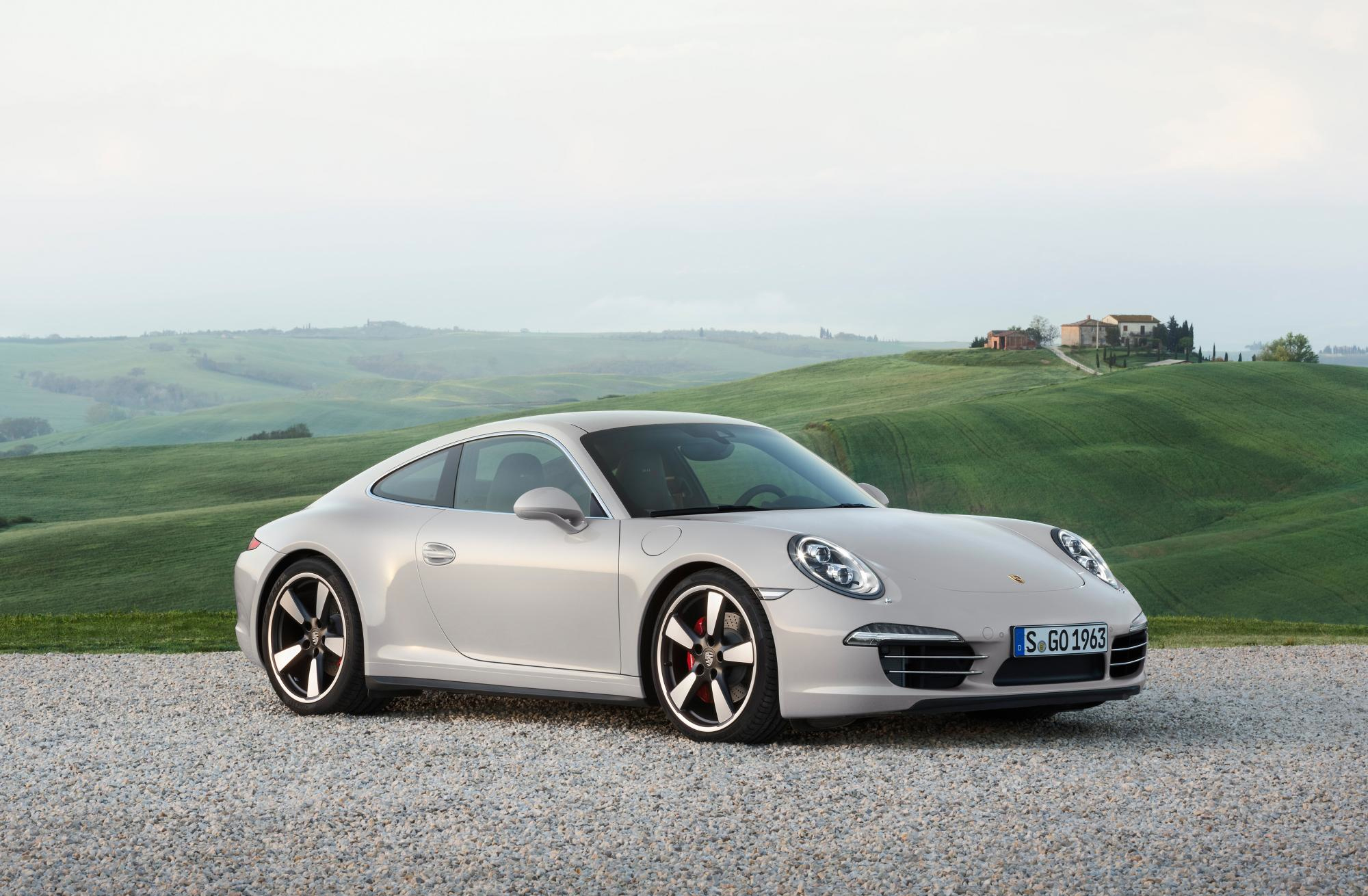
ATLANTA, June 3, 2013 – The Porsche 911 resolves apparent contradictions like no other sports car – such as between tradition and innovation or between exclusivity and high social acceptance, and of course between performance and efficiency. And so, Porsche is celebrating the 50th anniversary of the 911 at the International Motor Show (IAA) in Frankfurt with a special anniversary model based on the 911 Carrera S: like the original 911, the 911 50th Anniversary Edition is a coupe with a flat-six rear engine and rear wheel drive. Its efficient performance, active sport suspension – and special body have current relevancy: the anniversary 911 features the wide body, which is typically reserved for the all-wheel drive Carrera 4 models. This special edition will be limited to 1963 cars, a number that represents the year of the 911 world premiere.
For the US market, the 911 50th Anniversary Edition will be equipped as standard with a Powerkit, which increases engine performance to 430 hp and includes the Sport Chrono Package. The 911 50th Anniversary Edition sprints from zero to 60 mph in 4.2 seconds (3.8 with PDK) and can reach a top speed of 186 mph (185 with PDK). The limited edition models will be available at Porsche dealers this fall and will be priced from $124,100, not including a $950 destination charge.
Porsche will present the limited edition model in time for the 50th anniversary of the 911 at the IAA motor show in Frankfurt, which opens its gates to the public on September 12, 2013. In 1963, Porsche presented the original model to the public at this leading international show for the automotive industry. Since its first presentation – initially as the type 901 – the sports car icon has excited automotive fans across the globe, and today it is considered the reference for all other sports cars. Since making its debut in 1963, the model series has progressively developed without interruption. In the process, the unique character of the 911 was always preserved. The result of this evolution over a 50-year period – which included countless race victories as well – is a sports car that fully embodies the authenticity of the Porsche brand. Its DNA is reflected in all Porsche models.
This limited edition of the 911 Carrera S includes features that have contributed to the 50-year success story of the 911. For example, the limited edition includes Porsche Active Suspension Management (PASM) with special tuning to complement its increased track width and to add support to the exceptional cornering dynamics of the 911. The sport exhaust system outputs a fitting emotional sound. Special 20-inch wheels are a visual tribute to the legendary “Fuchs” wheels and are finished in matte black paint with machine-polished centers. Chrome trim strips on the front air inlets, the fins of the engine compartment grille and the panel between the rear lights emphasize the distinctive appearance of this limited edition model. Another technical highlight of the car’s equipment is the Porsche Dynamic Light System (PDLS) with bi-xenon headlights and dynamic cornering lights.
Two unique colors are available for the anniversary 911, a darker graphite grey and a lighter geyser grey metallic. In addition black monochrome is also available. Each of the cars has a two-tone 3D-effect badge on the rear lid with the numbers “911 50”. This is repeated in three color embroidery on the headrest and in two colors as a logo on the tachometer and the aluminum door sill plates. It can also be found on the cup holder panel together with the limited edition number of the individual vehicle. Other exterior characteristics of the special model are high-gloss window frames and sport design exterior mirrors on the doors panels.
There are tributes to the original 911 in the interior as well: green labeling on the instruments with white pointer needles and silver caps on the instrument pivot pins, just like 50 years ago. Another special feature is the center panels of the leather seats, which are designed with a fabric pattern reminiscent of the “Pepita” tartan design from the 1960s. The full-leather interior is designed in agate grey or black with decorative stitching, some in contrasting color. The driver and front passenger experience typical 911 driving fun in 14-way sport seats or optional 18-way sport seats plus. The gear shift or selector lever – which matches the decorative panels on the dashboard, doors and center console in brushed aluminum – comes from the Porsche Exclusive program.
Atlanta.The 918 Spyder embodies the essence of the Porsche idea: it combines pedigree motor racing technology with excellent everyday utility, and maximum performance with minimum consumption. The task faced by the development team was to create the super sports car for the next decade with a highly efficient and powerful hybrid drive. Developing the car from scratch, appropriately beginning with a sheet of white paper, allowed the team to come up with a no-compromise concept. The entire car was designed around the hybrid drive. The 918 Spyder therefore demonstrates the potential of the hybrid drive to a degree never seen before: the parallel improvement of both efficiency and performance without one being at the cost of the other. This is the idea that has made the Porsche 911 the most successful sports car in the world for 50 years. In short, the 918 Spyder will act as the gene pool for the Porsche sports cars of the future.
The 918 Spyder reveals its close links to motorsport in a variety of ways. It has been designed, developed and produced by Porsche engineers who build race cars, in cooperation with series production specialists. A great deal of insight gained from the development of Porsche race cars for the 24 hours race in Le Mans in 2014 is thus integrated into the 918 Spyder – and vice versa. The structural concept of the 918 Spyder with a rolling chassis as its basis – a basic vehicle that can be driven even without a body – is race car tradition at Porsche. The concept of the V8 engine originates from the LMP2 RS Spyder race car. The load-bearing structures, the monocoque and subframe, are made of carbon fiber reinforced polymer. Porsche has many years of experience with this high-strength, lightweight construction material and has again achieved top results with the development of the series production 918 Spyder. Many parts of the super sports car come from manufacturers who have a proven record as suppliers for motorsport vehicles.
Hybrid drive brings advantages in terms of driving dynamics
A key message of the 918 Spyder is that the hybrid drive from Porsche is a plus for no-compromise driving dynamics. Drivers can experience this thanks to the unique all-wheel drive concept with a combination of combustion engine and electric motor on the rear axle and the second electric motor on the front axle. It is based on knowledge gained by Porsche during motor races with the successful 911 GT3 R Hybrid. Due to the additional, individually controllable front drive, new driving strategies for extremely high, safe cornering speeds can be implemented, especially for bends. Furthermore, the advanced “boost” strategy manages the energy of the electric drive so intelligently that, for every sprint with maximum acceleration, the full power of the 918 Spyder can be tapped into by simply pressing the accelerator down fully. In short, the 918 Spyder allows even drivers without motorsport training to experience the potential of advanced longitudinal and transverse dynamics.
The Porsche 918 Spyder also has the potential to break many records. The current lap time for the North Loop of the Nürburgring is 7:14 minutes. This time was achieved in the presence of international journalists during test drives in September 2012 – more than a year before start of production. The 918 Spyder prototype was therefore approximately 20 seconds quicker than the Porsche Carrera GT. More test drives on the Nürburgring North Loop will follow. An even more important factor is that the 918 Spyder surpasses previous models and competitors by far in its efficiency as well. As a plug-in hybrid vehicle, it systematically combines the dynamic performance of a racing machine with low fuel consumption. To sum it up: maximum driving fun with minimal fuel consumption.
Carbon monocoque guarantees lightweight design with a low center of gravity
The 918 Spyder utilizes the best state-of-the-art technologies, taken straight from motor racing, to achieve its top performance. The entire load-bearing structure is made of carbon fiber reinforced polymer (CFRP) for extreme torsional rigidity. Additional crash elements at the front and rear absorb and reduce the energy of a collision. The car’s unladen weight of approximately 3,715 lbs. (3,616 lbs. with “Weissach” package), an excellent low weight for a hybrid vehicle of this performance class, is largely attributable to this concept.
The drivetrain components and all components weighing over 110 lbs. are located as low and as centrally as possible within the vehicle. This results in a slightly rear end biased axle load distribution of 57 percent on the rear axle and 43 percent on the front axle, combined with an extremely low center of gravity at approximately the height of the wheel hubs, which is ideal for driving dynamics. The central and low position of the traction battery directly behind the driver not only supports efforts to concentrate masses and lower the center of gravity; it also provides the best temperature conditions for optimum battery power capacity.
Chassis with race car genes and rear-axle steering
The multi-link chassis of the Porsche 918 Spyder is inspired by motorsport design, complemented by additional systems such as the PASM adaptive shock-absorber system and rear-axle steering. Basically, this incorporates an electro-mechanical adjustment system at each rear wheel. The adjustment is speed-sensitive and executes steering angles of up to three degrees in each direction. The rear axle can therefore be steered in the same direction as the front wheels or in opposition to them. At low speeds, the system steers the rear wheels in a direction opposite to that of the front wheels. This makes cornering even more direct, faster and more precise, and it reduces the turning circle. At higher speeds, the system steers the rear wheels in the same direction as the front wheels. This significantly improves the stability of the rear end when changing lanes quickly. The result is very secure and stable handling.
Porsche Active Aerodynamic (PAA) for different driving modes
Porsche Active Aerodynamic (PAA), a system of adjustable aerodynamic elements, ensures unique and variable aerodynamics; its layout is automatically varied over three modes ranging from optimal efficiency to maximum downforce and is tuned to the operating modes of the hybrid drive system. In “Race” mode, the retractable rear wing is set to a steep angle to generate high downforce at the rear axle. The spoiler positioned between the two wing supports near the trailing edge of the airflow also extends. In addition, two adjustable air flaps are opened in the underfloor in front of the front axle, and they direct a portion of the air into the diffuser channels of the underbody structure. This also produces a “ground effect” at the front axle.
In “Sport” mode, the aerodynamic control system reduces the attack angle of the rear wing somewhat, which enables a higher top speed. The spoiler remains extended. The aerodynamic flaps in the underfloor area close, which also reduces aerodynamic drag and increases attainable vehicle speeds. In “E” mode, the control is configured entirely for low aerodynamic drag; the rear wing and spoiler are retracted and the underfloor flaps are closed.
Adjustable air inlets under the main headlights round off the adaptive aerodynamic system. When the vehicle is stationary and in “Race” and “Sport” mode, they are opened for maximum cooling air intake. In “E-Power” and “Hybrid” modes, they close immediately after the car is driven off in order to keep aerodynamic drag to a minimum. They are not opened until the car reaches speeds of approximately 81 mph or when cooling requirements are higher.
From comfortable to race-ready: five modes for three motors
The core of the 918 Spyder concept is its distribution of propulsive power among the three power units; their cooperation is controlled by an intelligent management system. To best exploit these different approaches, the Porsche developers defined five operating modes that can be activated via a “map switch” on the steering wheel, just like in motorsport cars. On the basis of this pre-selection, the 918 Spyder applies the most suitable operating and boost strategy without driver intervention, thus allowing the driver to concentrate fully on the road.
Quiet and elegant: “E-Power”
When the vehicle is started up, the “E-Power” mode is the default operating mode as long as the battery is sufficiently charged. In ideal conditions, the 918 Spyder can cover approximately 18 miles on purely electric power. Even in pure electric mode, the 918 Spyder accelerates from 0 to 62 mph in seven seconds and can reach speeds of up to 93 mph. In this mode, the combustion engine is only used when needed. If the battery’s charge state drops below a set minimum value, the vehicle automatically switches to hybrid mode.
Efficient and comfortable: “Hybrid”
In “Hybrid” mode, the electric motors and combustion engine work alternately with a focus on maximum efficiency and minimum fuel consumption. The use of individual drive components is modified as a function of the current driving situation and the desired performance. The Hybrid mode is typically used for a fuel economy-oriented driving style.
Sporty and dynamic: “Sport Hybrid”
In more dynamic situations, the 918 Spyder selects the “Sport Hybrid” mode for its power sources. The combustion engine now operates continuously and provides the main propulsive force. In addition, the electric motors provide support in the form of electric boosting or when the operating point of the combustion engine can be optimized for greater efficiency. The focus of this mode is on performance and a sporty driving style at top speed.
For fast laps: “Race Hybrid”
“Race Hybrid” is the mode for maximum performance and an especially sporty driving style. The combustion engine is chiefly used under high load, and charges the battery when the driver is not utilizing its maximum output. Again, the electric motors provide additional support in the form of boosting. Furthermore, the gear-shifting program of the PDK is set up for even sportier driving. The electric motors are used up to the maximum power output limit to deliver the best possible performance for the race track. In this mode, the battery charge state is not kept constant, rather it fluctuates over the entire charge range. In contrast to Sport Hybrid mode, the electric motors run at their maximum power output limit for a short time for better boosting. This increased output is balanced by the combustion engine charging the battery more intensively. Electric power is thus available even with several very fast laps.
For pole position: “Hot Lap”
The “Hot Lap” button in the middle of the map switch releases the final reserves of the 918 Spyder and can only be activated in “Race Hybrid” mode. Similar to a qualification mode, this pushes the traction battery to its maximum power output limits for a few fast laps. This mode uses all of the available energy in the battery.
Main propulsion: the race car’s eight cylinder engine
The main source of propulsion is the 4.6-liter, eight cylinder engine that produces 608 hp of power. The engine is derived directly from the power unit of the successful RS Spyder, which explains why it can deliver engine speeds of up to 9,150 rpm. Like the race engine of the RS Spyder, the 918 Spyder power unit features dry-sump lubrication with a separate oil tank and oil extraction. To save weight, components such as the oil tank, the air filter box integrated into the subframe and the air induction are made of carbon fiber reinforced polymer. Further extensive lightweight design measures have resulted in such features as titanium connecting rods, thin-wall, low-pressure casting on the crank case and the cylinder heads, a high-strength, lightweight steel crankshaft with 180 degrees crankpin offset and the extremely thin-walled alloy steel/nickel exhaust system. Striking features of the V8 are that it no longer supports any auxiliary systems, there are no external belt drives and the engine is therefore particularly compact. Weight and performance optimizations achieve a power output per liter of approx. 133 hp/l – the highest power output per liter of a Porsche naturally aspirated engine – which is significantly higher than that of the Carrera GT (106 hp/l) and outstanding for a naturally aspirated engine.
Unique race car design heritage: top pipes
It isn’t just this engine’s performance but also the sound it makes that stokes the emotionality of the 918 Spyder. This is attributable first and foremost to the so-called top pipes: the tailpipes terminate in the upper part of the rear end immediately above the engine. No other production vehicle uses this solution. The top pipes’ greatest benefit is optimal heat removal, because the hot exhaust gases are released via the shortest possible route, and exhaust gas back pressure remains low. This design requires a new thermodynamic air channeling concept. With the HSI engine, the hot side is located inside the cylinder V, the intake channels are on the outside. There is another benefit as well: the engine compartment remains cooler. This is especially beneficial to the lithium-ion traction battery, as it provides optimum performance at temperatures between 68 and 104 degrees Fahrenheit. Consequently, less energy needs to be used for active cooling of the battery.
In parallel in the drivetrain: hybrid module
The V8 engine is coupled to the hybrid module, since the 918 Spyder is designed as a parallel hybrid like the current hybrid models from Porsche. Essentially, the hybrid module comprises a 115 kW electric motor and a decoupler that serves as the connection with the combustion engine. Because of its parallel hybrid configuration, the 918 Spyder can be powered at the rear axle either individually by the combustion engine or electric motor or via both drives jointly. As is typical for a Porsche super sports car, the power pack in the 918 Spyder has been placed in front of the rear axle, and does not have any direct mechanical connection to the front axle.
Upside-down for a low center of gravity: Doppelkupplung
A seven-speed Doppelkupplung (PDK) transmission handles power transmission to the rear axle. The high-performance transmission is the sportiest version of the successful PDK; it has undergone a complete redesign for the 918 Spyder and has been further optimized for high performance. To ensure a low mounting position for a low center of gravity of the entire vehicle, the gear unit was turned “upside down” by rotating it 180 degrees about its longitudinal axis, in contrast to other Porsche series. If no power is required on the rear axle, the two motors can be decoupled by opening the decoupler and PDK clutches. This is the action behind the Porsche hybrid drive’s typical “coasting” with the combustion engine switched off.
Independent all-wheel drive: front axle with electric motor
On the front axle, there is another independent electric motor with an output of approximately 95 kW. The front electric drive unit drives the wheels at a fixed ratio. A decoupler decouples the electric motor at high speeds to prevent the motor from over-revving. Drive torque is independently controlled for each axle. This makes for very responsive all-wheel drive functionality that offers great potential in terms of traction and driving dynamics.
Lithium-ion battery with plug-in charging system
The electric energy for the electric motors is stored by a liquid-cooled lithium-ion battery comprising 312 individual cells with an energy content of about seven kilowatt hours. The battery of the 918 Spyder has a performance-oriented design in terms of both power charging and output, so that it can fulfill the performance requirements of the electric motor. The power capacity and the operating life of the lithium-ion traction battery depend on several factors, including thermal conditions. That is why the battery of the 918 Spyder is liquid-cooled by a dedicated cooling circuit. The global warranty period for the traction battery is seven years.
To supply it with energy, Porsche developed a new system with a plug-in vehicle charge port and improved recuperation potential. This vehicle charge port in the B-pillar on the front passenger side lets users connect the storage battery to an electrical supply at home to charge it. The charge port is standardized for the country of purchase. The on-board charger is located close to the traction battery. It converts the alternating current of the household electric supply into direct current with a maximum charge output of 3.6 kW. Using the supplied Porsche Universal Charger (AC), the traction battery can be charged with a conventional wall plug in seven hours from a ten ampere rated, fused power socket a US 110 Volt household electrical supply, for example. Furthermore, the Porsche Universal Charger (AC) can be installed at home in the garage using the Charging Dock. It enables rapid and convenient charging within approximately two hours, irrespective of regional conditions. The Porsche Speed Charging Station (DC) is available as an optional extra. It can fully charge the high-voltage battery of the 918 Spyder in just 25 minutes.
Pioneering control concept: clear organization of the cockpit
The driver is the focus of all technology in the future Porsche super sports car. A cockpit was created for the driver that is typical of the brand and pioneering in its clarity. It is partitioned into two basic areas. First, there are the controls that are important for driving, which are grouped around the multifunction steering wheel, combined with driver information displayed on three large round instruments. Second, there is the infotainment block that is housed in the lifted center console, which was introduced in the Carrera GT. Control functions, e.g. for the automatic climate control system, wing adjustment, lighting and Porsche Communication Management (PCM), including a Burmester high-end sound system, can be intuitively operated by multitouch with a new type of black panel technology.
For even higher performance: the Weissach package
For very performance-oriented customers of the 918 Spyder, Porsche offers the “Weissach” package. These modified super sports cars can be recognized at first glance by special colors and designs that are based on legendary Porsche race cars. The roof, rear wings, rear-view mirrors and frames of the windscreen are made of visible carbon. Parts of the interior are upholstered with Alcantara instead of leather, and visible carbon replaces much of the aluminum. Sound insulation has been reduced. The emphasis on performance is not just visual: very lightweight magnesium wheels reduce unsprung masses; gross weight was reduced by about 77 lbs. The benefits are experienced in further improved dynamic performance. Other references from motorsport are six-point seatbelts for driver and front passenger, optional film-coating instead of body paint, as well as additional aerodynamic body parts in visible carbon.
Porsche redefined: a new super sports car for a new decade
The 918 Spyder continues a long tradition of super sports cars at Porsche; as technology platforms, as the driving force behind both car emotion and car evolution and as the ultimate sports cars of their decades: the Carrera GTS, the first Porsche Turbo, the 959, the 911 GT1, the Carrera GT. More than any of its predecessors, the 918 Spyder is providing key impetus for developing technologies for future vehicle concepts. It offers a complete package of components that reflect Porsche DNA – more concentrated than ever before.
Technical Specifications – Porsche 918 Spyder
Body: Two-seat Spyder; carbon fiber reinforced plastics (CFRP) monocoque interlocked with CFRP unit carrier; two-piece Targa roof; fixed roll-over protection system.
Drivetrain: Parallel full hybrid; 4.6-liter V8 mid-engine with dry-sump lubrication; hybrid module with electric motor and decoupler; electric motor with decoupler and gear unit on front axle; auto start/stop function; electrical system recuperation; four cooling circuits for motors, transmission and battery; thermal management.
Engine power: 608 hp at 8,600/min (V8 engine)
154 hp (hybrid module on rear axle)
127 hp (electric motor on front axle)
887 hp (combined)
Max. torque: 390 lb.-ft. at 6,600/min (V8 engine)
940 lb.-ft. (equivalent torque calculated on the crankshaft, complete system in 7th gear)
787 lb.-ft. (complete system, 3rd gear)
> 590 lb.-ft. (800/min – 5,000/min)
Maximum Revs: 9,150 rpm
Power output per l: 133 hp/l (V8 engine)
Power transmission: Combustion engine with hybrid module and transmission bolted together to form a single drive unit; seven-speed Doppelkupplungsgetriebe (PDK); rear-wheel drive; front electric motor with gearbox for driving the front wheels (decoupled from 146 mph); five pre-selectable operating modes for optimum coordination of all drive units.
Gear ratios PDK
1st gear 3.91
2nd gear 2.29
3rd gear 1.58
4th gear 1.19
5th gear 0.97
6th gear 0.83
7th gear 0.67
R gear 3.55
Final drive ratio 3.09
Clutch diameter 8.7 in. / 6.5 in.
Chassis and Suspension: Double-wishbone front axle; optional electro-pneumatic lift system on front axle; electro-mechanical power steering; multilink rear axle with adaptive electro-mechanical system for individual rear wheel steering; electronically controlled twin-tube gas-pressure dampers in the front and rear with Porsche Active Suspension Management (PASM).
Brake system: High-performance hybrid brake system with adaptive recuperation; internally ventilated and perforated front ceramic brake discs (PCCB), 16 in. in diameter and 1.4 in. thick; rear discs 15.4 in diameter and 1.3 in. thick.
Wheels and tires: 918 Spyder wheels
(Weissach package: 918 Spyder magnesium wheels)
front 9.5 J x 20 with 265/35 ZR 20
rear 12.5 J x 21 with 325/30 ZR 21
Weights: Curb weight 3,715 lbs.
3,616 lbs. (Weissach package)
Dimensions: Length 182.8 in.
Width 76.4 in.
Height 45.9 in.
Wheelbase 107.5 in.
Track width front 65.5 in.
rear 63.5 in.
Luggage compartment capacity, VDA ~ 110 l
Fuel tank capacity 18.5 gal
Energy supply: Lithium-ion battery with 6.8 kWh capacity (BOL nominal), 220 kW maximum power and mains-compatible plug-in charger.
Performance: Top speed > 211 mph
purely electric 93 mph
Acceleration:
0-62 mph 2.8 s
0-60 mph less than 2.8 s
0-62 mph (in electric mode) 7.0 s
0-124 mph (0-200 km/h) 7.9 s
0-186 mph (0-300 km/h) 23.0 s
Range: Purely electric approx. 18 mi.
Warranty: Vehicle (Battery) 4 years (7 years)
Charging times:
AC charging on a household socket (110 V, 10 A): less than 7 hours
AC charging on an industrial socket (240 V, 30 A): less than 2 hours
DC charging on an industrial socket (400 V, 32 A): less than 0.5 hours.
